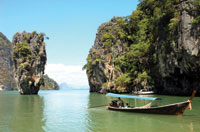Turning the tide

The tsunami came and the tsunami went.
And the good thing is that it didn’t take much time for the Thai people to come to terms with it and the human loss that accompanied the natural disaster.
But, what proved to be much more painful for the survivors in the aftermath of the natural disaster – especially for those in the south, which was hit the hardest – was the wait for the tourists to return. Since December 26, last year, visitors to Phuket, Krabi, Phang Nga, Trang, Satun and Ranong dropped dramatically due to concern over hygiene, safety, food, drinking water and the fear of disease. Apparently, more economic damage was done by cancellations and a downturn in visitor numbers than was done by physical destruction in the island resorts.
However, it didn’t take long for the efforts of the Thai government and the Tourism Authority of Thailand (TAT) to pay off – or, to put it differently, for the tide to turn!
Of course, most hotels in Phuket, Krabi, Phang Nga, Trang, Satun and Ranong are nowhere near the occupancy levels they were enjoying at around the same time last year but the good news is that the numbers are, slowly but surely, getting there. Yes, Khao Lak, Phi Phi, which were hugely damaged, are taking time to get back on their feet but then you have Phuket, which has made an amazing comeback. Tourists are swarming the balmy beaches restoring the smiles on the faces of the local people. As for the beaches of Hua Hin, Koh Samui, Pattaya, Koh Samet, Trang, they were far from the tsunami and all it took was the world to wake up to the fact.
By all accounts, the clean-up operation has been hugely impressive and it was difficult for me to imagine that the tsunami had wrecked havoc in this very place less than three months back. The Thai economy, for its, part has already recovered. Whilst tourism is a key component of GDP (around 7 per cent), the Thai economy is incredibly strong and forecasts for growth remain bullish with the Stock Exchange of Thailand likely to continue as one of the most competitive in Asia Pacific.
If anything, TAT feels the tsunami has come as a sort of blessing. Like Juthamas Siriwan, governor of the TAT, put it: “Although the tsunami has devastated some parts of Thailand’s prominent beach resorts, this natural disaster has been seen as a blessing in many aspects. Water quality, for instance, has improved tremendously, going back to what it was like 20 years ago.”
She went on to add: “Shallow water corals have seen around 10 per cent destruction which, in fact, is less serious than expected. In many areas, corals especially deepwater corals have been untouched. The beaches have seen little impact; in fact, many of them were cleared of the mess and debris that existed before the tsunami. Despite the damage, the Western Coast is better than before with cleaner, sandy white beaches and a healthier underwater environment!”
Most beaches have already been cleaned up and the debris and mess have long been removed. Lifeguard posts are being set up throughout the beaches and so are service centres, equipped with important equipments and tools. Addressing concerns about safety and reassuring future visitors, Siriwan said that an early warning system will be up and running soon and simple measures such as SMS text messaging are already in place.
Moving on, the TAT’s vision now is to develop and fix the image of Phuket as a world-class destination. The other five provinces of Phang Nga, Krabi Ranong, Trang and Satun will be promoted as a cluster. The short-term marketing measures include promoting domestic tourism in the six affected provinces to stimulate business; conducting campaigns to stimulate short-haul markets like Singapore, China, Hong-Kong, Japan, Korea and Taiwan; creating special packages by reducing prices of accommodation, entrance fees for national parks, airfares, landing fees at Phuket airport, etc; and organising mega events and international conferences in the Andaman region to promote tourism.
But that’s not all. Over time, TAT is working on upgrading the level of tourism in the affected provinces to feature both culture and nature products by introducing more culture and lifestyle-related packages such as exchanges with local people. Among others, it will establish a diving centre at Phi Phi Island similar to Koh Tao in Chumpon province that has received world acclaim and promote the six affected provinces for medical tourism and wellness and spa. Then, the Phuket International Airport and Krabi Airport are being expanded to accommodate up to 10 million passengers and small airports are being built to promote the transfer of tourists to different islands more easily.
But for now, the most important thing for Siriwan and her colleagues is to get the tourists back. And she doesn’t mince word. “Post-SARS the recovery was quicker than expected but now I ask for your (media, travel agents and tour operators) help to get tourists to come back,” she implored. “Cooperation of the world media will assist in this task. TAT and the private sector will operate road shows and attend trade fairs worldwide over the coming months showing the Andaman area is safe, rejuvenated and operational with new facilities.”
For its part, Thai Airways, which recently flew down over 1,000 people for a mega Fam trip to the south of Thailand at a cost of 90 million baht, has already released cheap domestic airfares and packages to attract both domestic and international travellers to return to the tsunami-affected areas and see for themselves that everything is back on track.
All in all, everyone is working hard to see that the wide grin that Thailand is so famous for is restored to the Land of Smiles.
